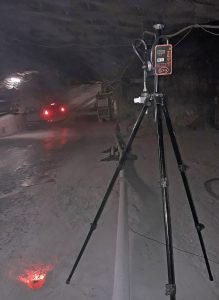The entry into force of further changes for underground mining pursuant to the revised Regulation for the Protection of Health in Mining Operations (GesBergV) on 24th October 2019 impacts in particular operations involving potash salt, rock salt, backfilling, gypsum, anhydrite, fluorspar and ore mining (1).
Previously, Section 13 of the GesBergV regulated the limitation of exposure to fibrogenic mine dust by requiring regular dust measurements; depending on the level of exposure, measurements were required at least once a year (Figure 1). Annex 10 specified the calculation of mining-specific threshold values that were determined on the basis of the percentage by mass of quartz in the fibrogenic dust. If this threshold was exceeded, work in the mine was prohibited.
The revision of § 13 GesBergV establishes new measures for underground non-bituminous coal mining operations in the event of fibrogenic mine dust contamination by referencing the Hazardous Substances Regulation and applicable rules of technology. The consequence is that, in addition to the metrological determination in accordance with number 402 of the Technical Rules for Hazardous Substances (TRGS), application of the provisions on occupational exposure thresholds in Chapter 2.4 of TRGS 900 has been mandatory since 24th October 2019, so the general dust threshold value for the alveolar fraction (A-dust) of 1.25 mg/m3 (exceedance factor 2) for fibrogenic or mineral mine dusts is now binding for underground mining as well. Employers must continue to carry out measurements and take samples at least once a year in accordance with a dust measurement schedule pursuant to § 11 GesBergV.
In addition, an analysis standard for quartz in A-dust of 0.05 mg/m3 (exceedance factor 8) must be observed for activities below and above ground (2), and “compliance” (while taking into consideration the minimisation principle) is required. The implementation of the analysis standard will be defined by the AGS in the newly revised TRGS 559 in the near future. Legitimate exceptions for listed activities for which compliance with this analysis criterion is not possible are fundamentally possible if a specific action plan is carried out.
When determining the amount of fibrogenic mine dust by measurements, the observance of the air threshold values mentioned above for A-dust and quartz in A-dust at workplaces during analysis of the measurement results has been mandatory since 24th October 2019. Compliance with the general dust threshold value for the E-fraction must always be checked as well.
References/Quellenverzeichnis
References/Quellenverzeichnis
(1) Art. 2 i.V.m. Art. 6 der Artikelverordnung zur Änderung der GesBergV sowie weiterer berg- und arbeitsschutzrechtlicher Verordnungen (BGBl. I Nr. 69, S. 3584) vom 18.10.2017.
(2) Bekanntmachung des BMAS (GMBl. S. 623 vom 06.07.2016)
